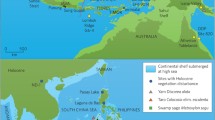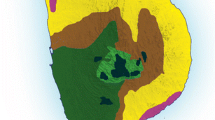Abstract
Questions concerning the availability of resources in tropical rain forests have given rise to the current debate centering on whether human subsistence based solely on foraging is possible in these biomes without agricultural subsidies. This paper takes the position that changing perspectives on ecological pattern and process in tropical forests and the significant variation among tropical forests on a worldwide as well as regional scale must be taken into consideration. Human disturbance is also proposed as a cause of dependence on agriculture by modern human foragers rather than as a necessary precondition for successful exploitation of the tropical forest. These issues are discussed against the background of a case study of the Yuquí, who, until very recently, were true foragers in the Bolivian Amazon. For the Yuquí, the sustainability of their subsistence system depended on a finegrained knowledge of their environment and the freedom of movement over a large territory to access resources within it.
Similar content being viewed by others
References
Ashton, P. S. (1988). Dipterocarp biology as a window to the understanding of tropical forest structure.Annual Review of Ecology and Systematics 19: 347–370.
Bailey, R. C. (1985). The Socioecology of Efe Pygmy Men in the Ituri Forest, Zaire. Unpublished Ph.D. dissertation, Harvard University.
Bailey, R. C., and Peacock, N. R. (1988). Efe Pygmies of Northeast Zaire: Subsistence strategies in the Ituri Forest. In de Garine, I., and Harrison, G. A. (eds.),Coping with Uncertainty in Food Supply. Clarendon Press, Oxford, pp. 88–117.
Bailey, R. C., Head, G., Jenike, M., Owen, B., Rechtman, R., and Zechenter, E. (1989). Hunting and gathering in tropical rain forest: Is it possible?American Anthropologist 91: 59–82.
Balée, W. (1987). A etnobotanica quantitiva dos indios Tembe (Rio Gurupi, Para).Boletim do Museu Paranse Emilia Goeldi Boiânica 3(1): 29–50.
Begon, M., Begon, M., Harper, J. L., and Townsend, C. R. (1990).Ecology, Individuals, Populations, and Communities. Blackwell Scientific Publications, Boston.
Boom, B. M. (1987). Ethnobotany of the Chacobo Indians, Beni, Bolivia.Advances in Economic Botany 4: 1–68.
Charnov, E. L. (1976). Optimal foraging: The marginal value theorem.Theoretical Population Biology 9: 129–136.
Dadant and Sons (eds.) (1975).The Hive and the Honey Bee. Dadant and Sons, Hamilton, Illinois.
Denslow, J. S. (1987). Tropical rainforest gaps and tree species diversity.Annual Review of Ecology and Systematics 18: 431–452.
Denslow, J. S., Schultz, J. C., Vitousek, P. M., and Strain, B. R. (1990). Growth responses of tropical shrubs to treefall gap environments.Ecology 71: 165–179.
Feinsinger, P., et al. (1988). Mixed support for spatial heterogeneity in species interactions; Hummingbirds in a tropical disturbance mosaic.American Naturalist 131(1): 33–57.
Foster, R. B. (1980). Heterogeneity and disturbance in tropical vegetation. In Soule, M. E., and Wilcox, B. A. (eds.),Conservation Biology: An Evolutionary-Ecological Perspective. Sinauer, Sunderland, Mass., p. 75–92.
Fox, R. G. (1969). Professional primitives': Hunters and gatherers of nuclear South Asia.Man in India 49(2): 139–160.
Fragoso, J. (in press). Effect of hunting on Tapir populations in Belize. In Robinson, J. G. and Redford, K. H. (eds.),Neotropical Wildlife Use and Conservation. University of Chicago Press, Chicago.
Harris, L. D. (1984).The Fragmented Forest. Island Biogeography Theory and the Preservation of Biotic Diversity. University of Chicago Press, Chicago.
Hartshorn, G. S. (1978). Treefalls and tropical forest dynamics. In Tomlinson, P. B., and Zimmerman, M. H. (eds.),Trees as Living Systems. Cambridge University Press, New York.
Headland, T. N. (1985). Why foragers do not become farmers: A historical study of a changing ecosystem and its effects on a negroito hunter-gatherer group in the Philippines. Unpublished Ph.D. dissertation, University of Hawaii.
Headland, T. N. (1987). The wild yam question: How well could independent hunter-gatherers live in a tropical rainforest environment?Human Ecology 15(4): 463–491.
Hill, K. (1983). Adult Male Subsistence Strategies Among Ache Hunter-Gatherers of Eastern Paraguay. Unpublished Ph.D. dissertation, University of Utah.
Holmberg, A. (1969).Nomads of the Long Bow. Natural History Press, New York.
Jacobs, M. (1981). In Kruk, R. et al. (ed.),The Tropical Rainforest: A First Encounter. Springer-Verlag, Berlin.
Kempff Mercado, N. (1973). African bee report published in Bolivia.American Bee Journal 113: 344.
Kempff Mercado, N. (1980).Flora Apicola Subtropical de Bolivia. Universidad Mayor Gabriel Rene Moreno, Santa Cruz, Boliva.
Levey, D. J. (1988a). Spatial and temporal variation in Costa Rican fruit-eating bird abundance.Ecological Monographs 58(4): 251–269.
Levey, D. J. (1988b). Tropical wet forest treefall gaps and distributions of understory birds and plants.Ecology 69(44): 1076–1089.
Levey, D. J. (1990). Habitat-dependent fruiting behavior of an understorey tree,Miconia centrodesma, and tropical treefall gaps as keystone habitats for frugivores in Costa Rica.Journal of Tropical Ecology 6(4): 409–420.
Needham, R. (1972). Penan. In Le Bar, F. (ed.),Ethnic Groups of Insular Southeast Asia (Vol 1), HRAF Press, New Haven, pp. 176–180.
Odum, E. P. (1971).Fundamentals of Ecology (3rd Ed). Saunders, Philadelphia.
Peters, C. M., Balick, M. J., Kahn, F., and Anderson, A. B. (1989). Oligarchic forests of economic plants in Amazonia: Utilization and conservation of an important tropical resource.Conservation Biology 3(4): 341–349.
Posey, D. (1983). Indigenous knowledge and development: An ideological bridge to the future.Ciencia e Cultura 35(7): 877–894.
Posey, D. (1987). Ethnoentomological survey of Brazilian Indians.Entomologia Generalis 12(2/3): 191–202.
Posey, D., and Franco de Camargo, J. M. (1985). Additional notes on the classification and knowledge of stingless bees (Meliponinae, Apidea, Hymenoptera) by the Kayapo Indians of Gorotire, Para, Brazil.Annals of Carnegie Museum (Carnegie Museum of Natural History, Pittsburgh) 54(8): 247–259.
Putz, F. E., and Appanah, S. (1987). Buried seeds, newly dispersed seeds, and the dynamics of a lowland forest in Malaysia.Biolropica 19(4): 326–333.
Putz, F. E., and Brokaw, N. V. L. (1989). Sprouting of broken trees on Barro Colorado Island.Ecology 70: 508–512.
Rambo, A. T. (1985).Primitive Polluters: Semang Impact on the Malaysian Tropical Forest Ecosystem. University of Michigan Press, Ann Arbor.
Redford, K. H., and Robinson, J. (19878). The game of choice: Patterns of Indian and colonist hunting in the neotropics.American Anthropologist 89(3): 650–667.
Richards, P. W. (1952).The Tropical Rainforest, an Ecological Study. Cambridge University Press, Cambridge.
Robinson, J., and Redford, K. H. (1986). Body size, diet, and population density of neotropical forest mammals.American Naturalist 128: 665–680.
Salo, J., Kalliola, R., Häkinen, Y., Niemelä, P., Puhakka, M., and Coley, P. D. (1986). River dynamics and the diversity of Amazon lowland forest.Nature 322: 254–258.
Sponsel, L. (1986). Amazon ecology and adaptation.Annual Review of Anthropology 15: 67–97.
Stearman, A. M. (1981). Working the “Africans” in Eastern Bolivia.American Bee Journal 122(1): 28, 30–35, 43–44.
Stearman, A. M. (1984). The Yuquí connection: Another look at Siriono deculturation.American Anthropologist 86(3): 630–650.
Stearman, A. M. (1989a). Yuquí foragers in the Bolivian Amazon: Subsistence strategies, prestige and leadership in an acculturing society.Journal of Anthropological Research 45(2): 219–244.
Stearman, A. M. (1989b).Yuquí: Forest Nomads in a Changing World. Holt, Rinehart and Winston, New York.
Stearman, A. M. (1990). The effects of settler incursion on fish and game resources of the Yuquí, a native Amazonian society of Eastern Bolivia.Human Organization 49(4): 373–385.
Terborgh, J. (1986a). Community aspects of frugivory in tropical forests. In Estrada, A. and Fleming, T. H. (eds.),Frugivores and Seed Dispersal. Dr. W. Junk Publishers, Dordrecht.
Terborgh, J. (1986b). Keystone plant resources in the tropical forest. In Souie, M. E. (ed.).Conservation Biology: The Science of Scarcity and Diversity, Sinauer, Sunderland, Mass.
Turnbull, C. (1961).The Forest People: A Study of the Pygmies of the Congo. Simon and Schuster, New York.
Turnbull, C. (1965a). The Mbuti Pygmies: An ethnographic survey.Anthropological Papers of the American Museum of Natural History 50(3): 139–282.
Turnbull, C. (1965b).Wayward Servants: The Two Worlds of the African Pygmies. Natural History Press, Garden City.
Author information
Authors and Affiliations
Rights and permissions
About this article
Cite this article
Stearman, A.M. Making a living in the tropical forest: Yuquí foragers in the Bolivian Amazon. Hum Ecol 19, 245–260 (1991). https://doi.org/10.1007/BF00888747
Issue Date:
DOI: https://doi.org/10.1007/BF00888747




